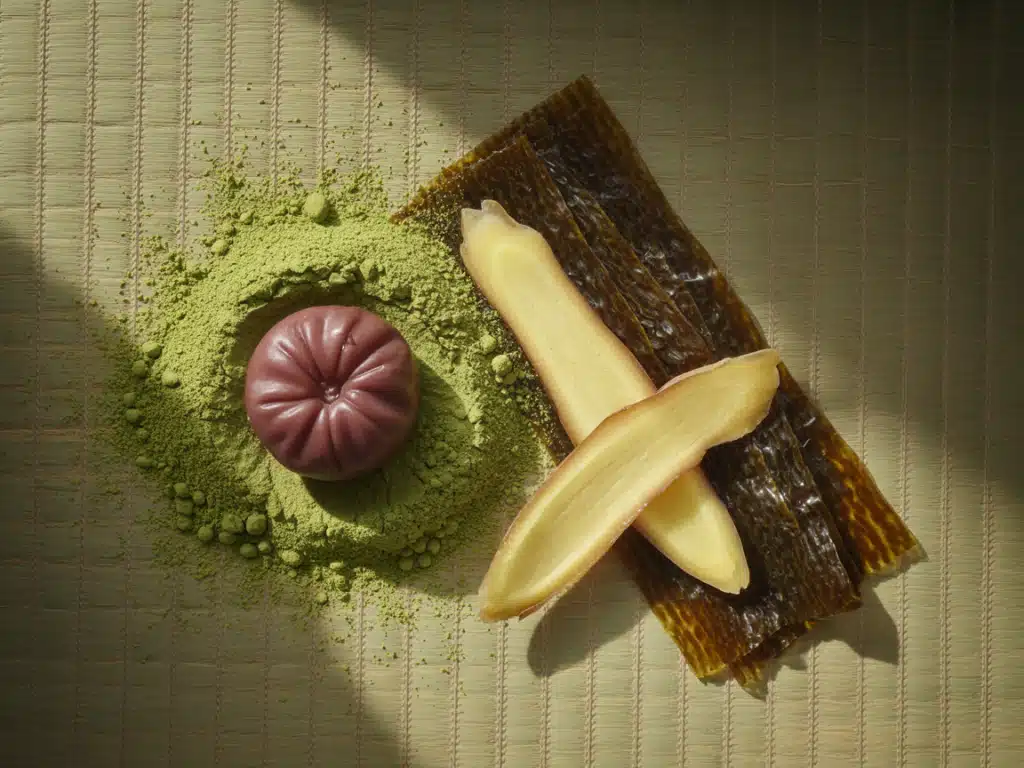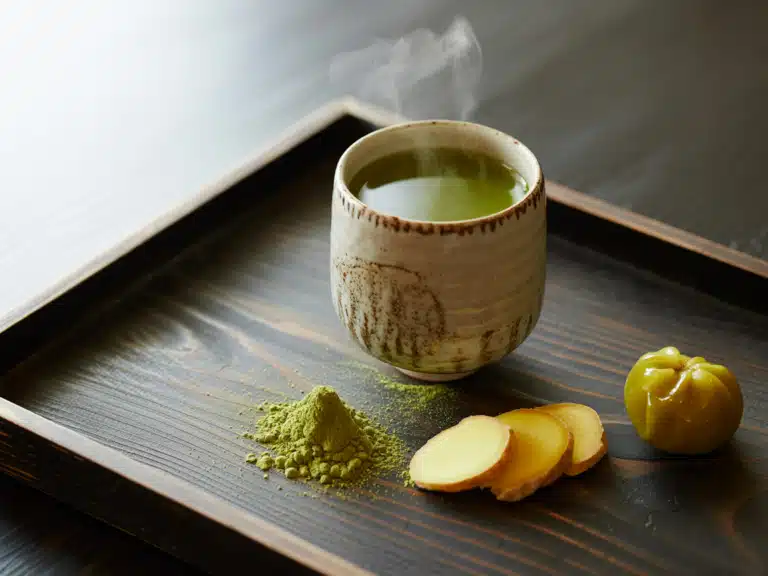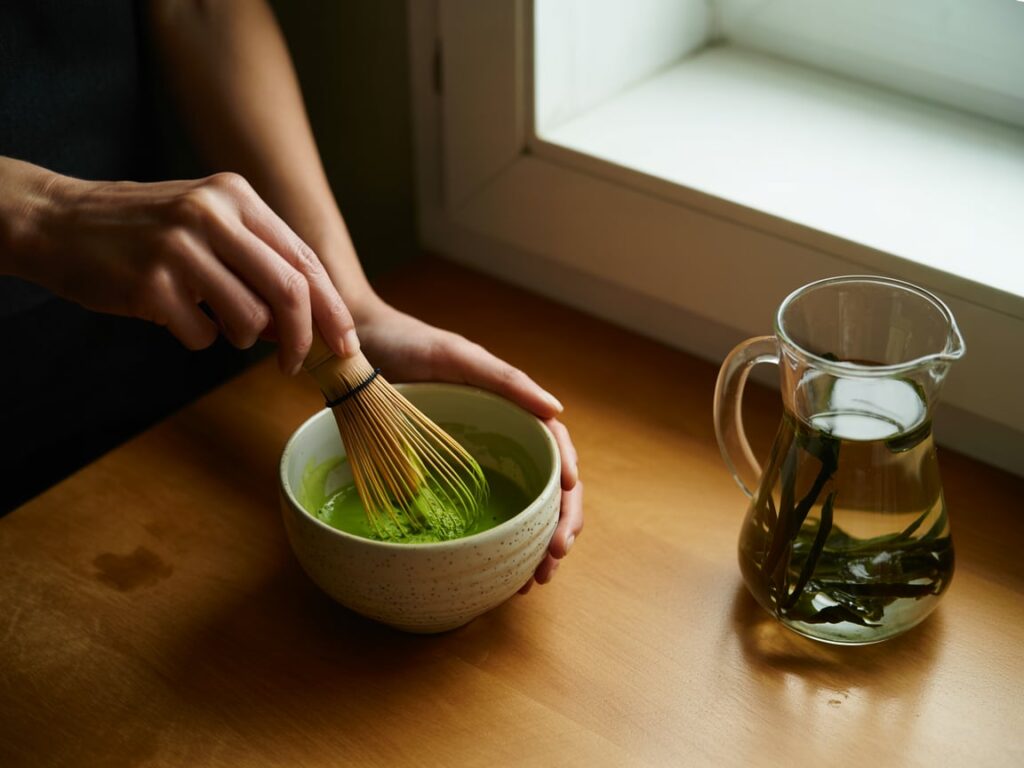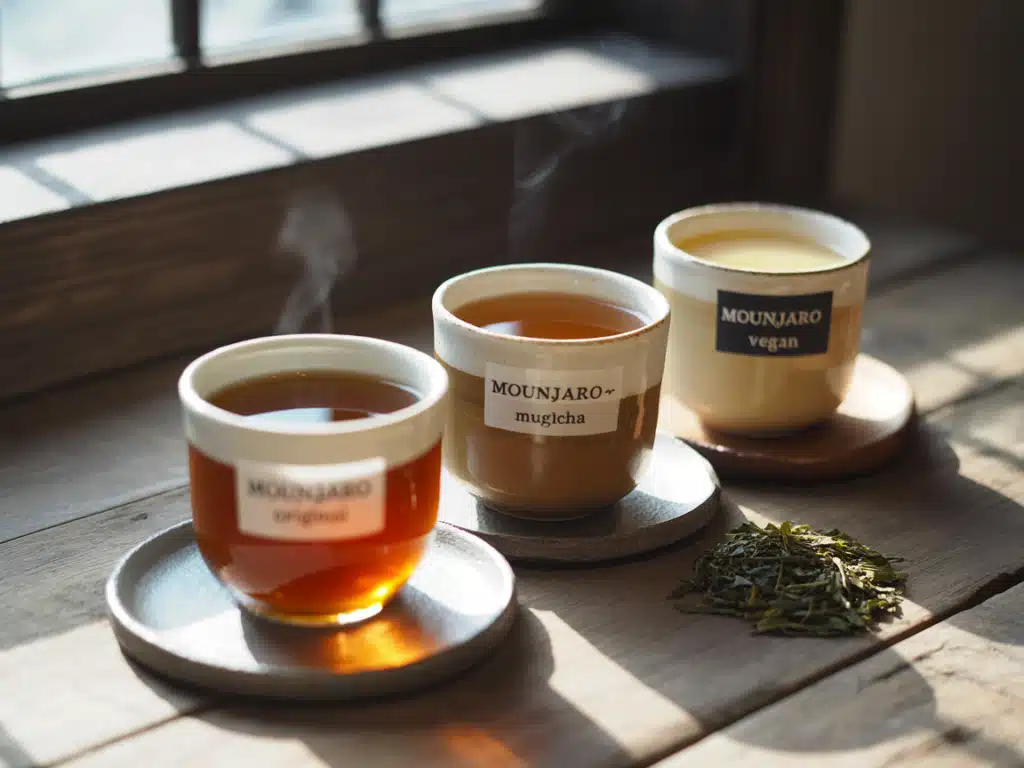If there’s one thing I’ve learned from a lifetime of cooking—first in my grandmother’s kitchen, now in my own cozy home with my two little ones—it’s that the most powerful recipes are often the simplest. That’s exactly why the Japanese Mounjaro recipe caught my attention. As someone who’s always sought out nourishing, comforting meals made from everyday ingredients, this natural Japanese tonic resonated deeply with my passion for holistic, joyful cooking.
At Cozy Bites Recipes, my mission has always been to craft meals that warm the heart and support wellness from the inside out. The Japanese Mounjaro drink is no exception. Blending ancient Eastern tradition with modern wellness goals, it’s a metabolism-boosting blend of matcha, kombu, ginger, and umeboshi plum that’s gaining popularity—especially for those looking for natural alternatives to prescription weight-loss aids. Whether you’re curious about how to brew it properly, why it’s trending, or if it actually works, you’re in the right place.
Check out my full journey with other powerful blends like the Natural Mounjaro Recipe that sparked my inspiration for this article.
Let’s dive into the origins of this intriguing Japanese drink and explore how it could become your next daily ritual.
Table of Contents
What Is the Japanese Mounjaro Recipe?
Origins of the Japanese Mounjaro Drink
The Japanese Mounjaro recipe isn’t just a fleeting social media trend—it’s a wellness tradition inspired by centuries of natural healing in Japanese culture. Unlike the pharmaceutical Mounjaro (tirzepatide) used for diabetes and weight loss, the Japanese version is entirely natural. Its roots lie in Japanese folk remedies, tea ceremonies, and fermented superfoods that prioritize balance, digestion, and metabolic energy.
This drink combines matcha (a potent form of green tea), umeboshi plum (a salty, tangy fermented fruit), kombu (a mineral-rich seaweed), and fresh ginger, all steeped in warm water. Each ingredient has a functional purpose—detoxifying the liver, boosting metabolism, and enhancing digestion naturally.
What makes this blend especially powerful is its ability to mimic the effects of prescription Mounjaro by targeting the same body functions—appetite control and glucose management—but without any artificial chemicals or injections.
Why This Natural Recipe is Trending in the USA
As awareness grows about the potential side effects of synthetic weight loss medications, health-conscious individuals are turning to natural alternatives like the Japanese Mounjaro recipe. Social media influencers, nutritionists, and everyday home cooks are praising its simplicity and effectiveness. It fits perfectly into plant-based, low-calorie, and gut-friendly lifestyles, making it a popular choice for anyone looking to burn fat, improve energy levels, or simply feel lighter and healthier.
This rise in popularity has also been driven by the demand for functional beverages—drinks that do more than just hydrate. In fact, a quick morning cup of this brew may support your metabolism better than your usual coffee, without the jitters.
Don’t miss our Brazilian Mounjaro Recipe for another powerful global variation with similar benefits.
Key Ingredients in the Japanese Mounjaro Recipe

Matcha: The Green Metabolism Booster
Matcha isn’t just a trendy coffeehouse alternative—it’s the soul of the Japanese Mounjaro recipe. Ground from the finest shade-grown green tea leaves, matcha contains high concentrations of EGCG (epigallocatechin gallate), a compound known to enhance fat oxidation and boost resting metabolic rate.
Unlike steeped green tea, matcha is consumed whole, offering 3x the antioxidants and more sustained energy without the crash. This makes it ideal for morning rituals or pre-workout fuel. Its thermogenic properties are a big reason this drink is considered a natural metabolism booster—and why it’s essential in any authentic Japanese Mounjaro recipe.
When preparing a Japanese Mounjaro recipe at home, make sure you choose ceremonial-grade matcha if possible—it has a smoother taste and a richer nutritional profile, ensuring maximum benefit and flavor.
Looking for inspiration? Try Chia Seeds Smoothie for another nutrient-dense drink packed with antioxidants.
Umeboshi Plum: Ancient Digestive Elixir
The Japanese Mounjaro recipe wouldn’t be complete without umeboshi plum, a centuries-old staple in Japanese kitchens. This fermented fruit delivers a one-two punch: alkalizing the body while stimulating digestion. It’s rich in organic acids, including citric acid, which supports the breakdown of fatty foods and detoxification.
In the Japanese Mounjaro recipe, umeboshi provides a tangy, salty kick that balances the bitterness of matcha. For a milder option, umeboshi paste works just as well.
Traditionally, umeboshi has also been used as a hangover cure, thanks to its potent cleansing effect on the liver and kidneys.
Kombu and Ginger: Gut-Friendly Superfoods
Kombu—a type of edible kelp—is loaded with iodine, calcium, magnesium, and alginate, a compound shown to inhibit fat absorption in the gut. In the Japanese Mounjaro recipe, its role is to provide essential minerals and help regulate metabolism naturally.
Soaking kombu in warm water allows these nutrients to infuse into the drink without overpowering the taste. Once steeped, it’s discarded—but its benefits remain in the water, forming a key part of the Japanese Mounjaro recipe base.
Ginger, on the other hand, brings heat and circulation. It’s a classic remedy for nausea and bloating but also helps enhance insulin sensitivity, making it a valuable addition to this metabolic-boosting Japanese Mounjaro recipe.
Don’t miss our Zobo Drink Recipe if you enjoy herbal infusions that support digestion and detox.
Together, these ingredients create a synergistic elixir that works on multiple metabolic pathways, promoting weight loss and gut health in one cup.
Print
Japanese Mounjaro Recipe
A traditional Japanese detox drink made with matcha, kombu, ginger, and umeboshi plum to support weight loss and energy naturally.
- Total Time: 10 minutes
- Yield: 1 1x
Ingredients
1 teaspoon matcha powder (good quality if possible)
1 umeboshi plum (or about 1 teaspoon umeboshi paste)
Green tea1 slice fresh ginger, finely grated
1 small piece dried kombu (thumb-sized)
8 ounces warm water (around 160–170°F)
Optional: splash of lemon juice or drizzle of honey
Instructions
Grate the ginger, measure the matcha, and prepare the kombu.
Heat water to 160–170°F, not boiling.
Steep the kombu in the warm water for 5 minutes.
In a separate bowl, whisk the matcha powder with a splash of warm water until frothy.
Remove kombu from the water.
Stir in the umeboshi, grated ginger, and frothy matcha into the kombu water.
Adjust flavor with lemon juice or honey if desired.
Notes
No umeboshi? Substitute with a pinch of sea salt and a squeeze of lemon. Add chia seeds or yuzu juice for extra boost. Cut matcha by half for a lower-caffeine version.
- Prep Time: 5 minutes
- Cook Time: 5 minutes
Nutrition
- Serving Size: 1 serving
- Calories: 25
- Sugar: 0g
- Sodium: 150mg
- Fat: 0g
- Carbohydrates: 5g
- Fiber: 1g
- Protein: 1g
Step-by-Step Japanese Mounjaro Recipe Guide

Tools and Prep: What You Need
Before making your first cup of this natural metabolic drink, it’s essential to prepare the right tools and ingredients. Fortunately, this recipe is incredibly approachable—you don’t need a full tea ceremony setup to get started.
Kitchen tools you’ll need:
- Small saucepan or kettle (to heat water)
- Fine grater (for fresh ginger)
- Bamboo whisk or milk frother (for matcha)
- Small mixing bowl or matcha bowl
- Wooden spoon or glass stirrer
- Fine strainer (optional)
Ingredients list (serves 1):
- 1 teaspoon matcha powder (preferably ceremonial-grade)
- 1 umeboshi plum or 1 teaspoon umeboshi paste
- 1 slice fresh ginger, finely grated
- 1 thumb-sized piece of dried kombu
- 8 ounces of warm water (160–170°F, not boiling)
- Optional: splash of lemon juice or drizzle of honey
Check out our guide to Lemon Balm Recipe for another soothing herbal blend perfect for mornings or winding down.
Complete Instructions with Brewing Tips
Let’s break it down into easy steps that you can follow even on a busy morning:
- Prep the ingredients
Grate the ginger, remove the pit from the umeboshi plum if using whole, and measure your matcha. Prepare your kombu by rinsing it briefly under water to remove any excess salt or residue. - Heat the water
Use a kettle with a temperature gauge, or simply heat until bubbles begin to form (not boiling). Aim for 160–170°F. Too hot, and you’ll scorch the matcha and kombu, reducing their benefits. - Steep the kombu
Add kombu to a cup or small pot and pour warm water over it. Let it steep for 5 minutes. Then, remove and discard the kombu. The infused water now contains minerals essential to the metabolic function. - Whisk the matcha
In a separate bowl, combine the matcha powder with a tablespoon of warm water. Use a bamboo whisk or electric frother to whisk briskly in a zigzag motion until it’s light and frothy. - Combine and stir
Pour the frothy matcha into the kombu-infused water. Add grated ginger and umeboshi plum (or paste). Stir well until the plum dissolves slightly. - Adjust to taste
Add a splash of lemon juice for tang, or honey for a touch of sweetness if the drink is too earthy or salty for your liking. - Serve and enjoy
Drink warm, ideally first thing in the morning on an empty stomach to maximize metabolic benefits.
For a different yet equally refreshing detox option, check out our Liver Flush Juice Recipe.
This recipe isn’t just simple—it’s mindful, meditative, and incredibly healing. With every sip, you’re nourishing your body and honoring an ancient Japanese wellness tradition.
Health Benefits of Japanese Mounjaro Drink
Weight Loss and Metabolism Acceleration
One of the biggest reasons the Japanese Mounjaro recipe has gone viral is its reputation as a natural metabolism booster. Unlike synthetic drugs, this drink taps into your body’s own metabolic processes—gently but effectively.
The star ingredient in the Japanese Mounjaro recipe, matcha, contains caffeine and catechins like EGCG, which have been shown in studies to increase thermogenesis (the rate at which your body burns calories) by up to 17%. This means your body is working more efficiently—burning fat even at rest.
But the magic doesn’t stop with matcha. Umeboshi plum, a fermented powerhouse, helps reduce sugar cravings and keeps you fuller for longer by supporting blood sugar stability. And let’s not forget kombu—its iodine content supports thyroid health, which plays a direct role in regulating your metabolic rate.
When these ingredients come together in the Japanese Mounjaro recipe, they help regulate appetite, improve fat oxidation, and support sustained energy levels—without causing jittery crashes like coffee or synthetic stimulants.
Want more energizing, natural drinks? Don’t miss our ABC Fruit Juice that’s packed with fiber and metabolic support.
Detoxification and Gut Health Support
The Japanese Mounjaro drink isn’t just a fat burner—it’s also a gentle daily detoxifier. Every ingredient was selected for its ability to aid in cleansing the digestive tract and eliminating toxins:
- Ginger stimulates digestive enzymes and reduces bloating.
- Umeboshi helps the liver process toxins more efficiently while promoting bile production.
- Kombu contains fucoidans and alginates, which help bind to heavy metals and flush them from the body.
The result? Improved digestion, better nutrient absorption, less bloating, and clearer skin—just by sipping on a warm cup in the morning.
These benefits mirror what many seek from synthetic medications, but without the side effects or dependency.
Looking for more natural cleansing options? Check out our Banana Peach Smoothie Recipe for a gut-friendly breakfast that pairs perfectly with this drink.
Natural Mounjaro Alternatives and Variations

What Is the Natural Version of Mounjaro?
The term “natural Mounjaro” has gained traction among wellness communities as people seek gentler, food-based solutions for weight loss, blood sugar control, and energy. While the prescription drug Mounjaro (tirzepatide) mimics GLP-1 hormones to regulate appetite and insulin, the natural Japanese Mounjaro recipe relies on botanical and fermented superfoods to create a similar effect.
This DIY alternative, known as the Japanese Mounjaro recipe, supports many of the same metabolic functions—without the risks or costs associated with pharmaceuticals. In fact, the umeboshi and matcha combination at the heart of the Japanese Mounjaro recipe has been part of Japan’s wellness culture for centuries, long before weight loss injections were even invented.
The natural version of Mounjaro:
- Is made from real, whole ingredients
- Supports appetite regulation and digestion
- Promotes long-term wellness over short-term fixes
- Costs a fraction of pharmaceutical options
- Is safe to use daily with minimal to no side effects
Want a twist? Our High-Protein Dense Bean Salad makes a perfect meal pairing for balanced blood sugar and increased satiety.
Vegan and Caffeine-Free Japanese Mounjaro Alternatives
Some readers ask, “What if I can’t have caffeine or follow a vegan lifestyle?” Good news—this recipe is easy to modify:
Caffeine-Free Version:
- Replace matcha with roasted barley tea (mugicha) or dandelion root tea.
- Both have metabolism-enhancing benefits without any caffeine content.
- Mugicha is often served in Japanese households and offers a roasted, nutty flavor.
Vegan-Friendly Version:
- The base recipe is already vegan, but make sure to:
- Choose vegan-certified umeboshi paste (some may contain bonito flakes).
- Avoid honey, using agave nectar or maple syrup instead.
Add-on ideas for personalized nutrition:
- A splash of apple cider vinegar for extra detox.
- Ashwagandha powder for stress support and hormone balance.
- A pinch of cayenne pepper to boost circulation and fat burn.
These simple swaps help you tailor the Japanese Mounjaro drink to meet your wellness needs while maintaining its core benefits.
What Do Doctors and Experts Say About Japanese Mounjaro Recipe?
Doctor Reviews and Scientific Perspective
The growing popularity of the Japanese Mounjaro recipe has caught the attention of both wellness experts and functional medicine practitioners. While this drink hasn’t been formally studied like its pharmaceutical counterpart, many of its core ingredients are backed by scientific evidence supporting their metabolic and digestive benefits.
The Japanese Mounjaro recipe draws strength from ingredients backed by both tradition and science. Matcha, for example, has been the subject of numerous clinical studies. According to a review published in the American Journal of Clinical Nutrition, green tea catechins (specifically EGCG) were found to significantly increase fat oxidation and improve insulin sensitivity.
Ginger has long been known to aid digestion, and studies show it also helps regulate blood glucose and suppress appetite. In a 2015 study, ginger supplementation was linked to reductions in fasting blood sugar and hemoglobin A1C in people with type 2 diabetes.
And kombu, while less studied in Western medicine, is rich in iodine and fucoidans—compounds that support thyroid function and may promote anti-inflammatory effects in the gut. This aligns with Japanese naturopathic traditions that view kombu-infused drinks—like those in the Japanese Mounjaro recipe—as natural detoxifiers.
Functional nutritionists often recommend combining these ingredients for those looking to manage their weight or balance their hormones naturally. While no one claims this is a “magic bullet,” the synergy of the Japanese Mounjaro recipe makes it a powerful complement to a healthy lifestyle.
Potential Benefits vs. Risks
Because this recipe uses natural, food-grade ingredients, the risk of side effects is extremely low—especially when compared to the pharmaceutical drug Mounjaro, which can cause nausea, vomiting, or pancreatitis in some users.
However, there are a few points to keep in mind:
| Ingredient | Considerations |
|---|---|
| Matcha | Contains caffeine; avoid late at night or if caffeine-sensitive |
| Umeboshi Plum | High in sodium; those on a low-salt diet should use with caution |
| Kombu | Contains iodine; avoid overuse if you have thyroid disorders |
| Ginger | May lower blood sugar—monitor if you’re diabetic or taking glucose meds |
Doctors generally agree: if you’re using the Japanese Mounjaro drink as a supportive wellness practice, it’s safe and beneficial. But it’s always best to consult a healthcare provider, especially if you’re managing a chronic condition or taking medication.
Still unsure? Learn more about Natural Mounjaro Recipe and how people are using food-based solutions to replace pharmaceuticals.
How to Incorporate Japanese Mounjaro Recipe Into Your Routine
Best Times to Drink for Maximum Effect
To get the most from your Japanese Mounjaro recipe, timing is key. This isn’t just a feel-good tea—it’s a functional beverage designed to support metabolism, digestion, and natural energy regulation. The time of day you drink it can significantly influence how your body responds.
Morning Ritual (Highly Recommended):
Drinking the Japanese Mounjaro first thing in the morning, on an empty stomach, can:
- Jumpstart your metabolism
- Improve insulin sensitivity
- Set the tone for mindful eating throughout the day
It’s a gentle way to wake up your digestive system and replace coffee or sugar-heavy breakfast drinks.
Pre-Meal Boost:
Enjoying it 20–30 minutes before a meal can help regulate hunger and support portion control. Umeboshi and ginger are known appetite modulators, which means you’re more likely to eat intuitively.
Afternoon Slump Fix:
If caffeine doesn’t affect your sleep, you can sip it in the early afternoon to beat the post-lunch energy dip. Matcha delivers a steady release of energy, unlike the sharp highs and lows of coffee.
Not a morning person? Pair this drink with a gentle start like our Semolina Pudding Recipes to keep blood sugar balanced from your first bite.
Japanese Morning Rituals and Mounjaro Timing
In Japan, morning rituals are viewed as sacred moments to center the mind and prepare the body for the day. Many Japanese people begin their mornings with tea, warm water with lemon, or fermented foods like miso or umeboshi—all of which play key roles in the Japanese Mounjaro recipe. Incorporating these traditions, the Japanese Mounjaro recipe is more than a wellness trend—it’s a reflection of a mindful lifestyle rooted in centuries-old practices.
To incorporate this drink in a meaningful way:
- Begin with 5 minutes of deep breathing or light stretching
- Sip your Japanese Mounjaro slowly, allowing your body to absorb the warmth and nutrients
- Avoid pairing with sugary snacks or processed food—this defeats the purpose of cleansing and stabilizing your system
Creating a simple, repeatable morning self-care routine—even if just 10 minutes—can help anchor this drink into your lifestyle. And once it becomes habit, you’ll start noticing the difference in energy, mood, digestion, and even cravings.
Comparing Japanese Mounjaro to Prescription Mounjaro
Does the Japanese Mounjaro Drink Work Like the Drug?
If you’ve been hearing about Mounjaro (tirzepatide) from weight loss communities or doctors, you’re probably wondering how the Japanese Mounjaro recipe stacks up. While they share a name, they’re very different tools—one is a prescription medication developed for type 2 diabetes, the other is a natural, functional drink rooted in traditional Japanese wellness practices.
Prescription Mounjaro:
- A synthetic peptide that mimics GLP-1 and GIP hormones
- Slows gastric emptying and controls insulin release
- Requires a prescription and is often injected weekly
- May cause nausea, vomiting, or other side effects
Japanese Mounjaro Recipe:
- Combines matcha, kombu, umeboshi, and ginger to support metabolism
- Naturally regulates appetite, improves digestion, and provides clean energy
- Safe for daily use and accessible without a prescription
- Free of synthetic additives or hormones
So, does the Japanese Mounjaro drink work? Yes—but differently. It doesn’t replace GLP-1 agonists like tirzepatide, but instead supports similar bodily processes through diet and lifestyle. Think of it not as a substitute, but as a daily ritual that enhances metabolic function, gently and holistically.
Explore how others are also tapping into nature with our Pink Salt Recipe—another mineral-rich formula supporting hydration and balance.
Natural vs. Synthetic: What’s Right for You?
Here’s a quick breakdown to help you decide:
| Feature | Japanese Mounjaro Drink | Prescription Mounjaro (Tirzepatide) |
|---|---|---|
| Ingredients | Natural: matcha, ginger, kombu | Synthetic GLP-1/GIP mimetic |
| Administration | Oral (drink) | Injection |
| Cost | Low (kitchen ingredients) | High (monthly prescriptions) |
| Side Effects | Minimal to none | Common: nausea, diarrhea |
| Long-term Use | Safe for daily consumption | Requires medical supervision |
| Accessibility | DIY, no prescription needed | Prescription only |
For many people, the Japanese Mounjaro recipe offers a sustainable and empowering approach—a way to support health through nutrition, not medication. But if you’re dealing with medical conditions like diabetes, speak with your doctor about the best path forward. Many are open to integrating natural remedies with clinical care, and this drink may fit beautifully into a more holistic treatment plan.
DIY Tips for Making Your Own Natural Mounjaro: Japanese Mounjaro recipe
How to Make Japanese Mounjaro at Home
The beauty of the Japanese Mounjaro recipe lies in its simplicity. You don’t need exotic equipment or hard-to-find ingredients to create a powerful wellness drink right in your kitchen. With just a few thoughtful items, you can craft this restorative elixir in minutes.
DIY Ingredient List (Single Serving):
- 1 teaspoon matcha powder (preferably ceremonial-grade)
- 1 umeboshi plum (or 1 teaspoon umeboshi paste)
- 1 thumb-sized piece of dried kombu
- 1 slice of fresh ginger, finely grated
- 8 ounces warm water (160–170°F)
- Optional: splash of lemon juice or drizzle of honey
Basic Instructions Recap:
- Steep kombu in warm water for 5 minutes.
- Whisk matcha in a separate bowl until frothy.
- Remove kombu, stir in umeboshi, ginger, and matcha.
- Add lemon or honey to taste.
- Sip warm, preferably in the morning.
And remember—consistency is key. Incorporating the Japanese Mounjaro recipe into your daily or weekly wellness routine will deliver the best results over time.
Budget-Friendly Ingredient Swaps and Shortcuts
Don’t have access to high-end ingredients? No problem—here are some budget-conscious swaps that maintain the integrity of the Japanese Mounjaro recipe while making it more accessible:
| Original Ingredient | Affordable or Accessible Alternative |
|---|---|
| Ceremonial-grade Matcha | Culinary-grade matcha or green tea bag (less potent but still helpful) |
| Umeboshi Plum | Apple cider vinegar with sea salt (for similar acidity and effect) |
| Kombu | Nori sheet (though less iodine-rich, still mineral-packed) |
| Honey | Maple syrup, agave, or date syrup |
Want to go even further? Prep a week’s worth of the Japanese Mounjaro recipe by making a dry mix: combine powdered ginger and matcha in a small jar, then simply add umeboshi and kombu-infused water when you’re ready to sip.
If you’re building a full day of natural wellness, don’t miss our Bariatric Seed Recipe to support satiety and gut health throughout the day.
FAQ Section: Japanese Mounjaro Questions Answered
How do I make my own natural Mounjaro?
To make your own natural Mounjaro drink, combine 1 teaspoon matcha, 1 umeboshi plum (or paste), a slice of grated ginger, and a small piece of kombu steeped in 8 ounces of warm water (160–170°F). Steep the kombu first, then whisk matcha separately and combine all ingredients. Adjust flavor with lemon juice or honey. It’s a simple, effective way to support metabolism, digestion, and energy levels naturally.
What do doctors say about Japanese Mounjaro?
Doctors and nutrition experts acknowledge the ingredients in the Japanese Mounjaro recipe as beneficial, especially matcha and ginger, which have strong clinical support for metabolism and blood sugar control. While it doesn’t replicate pharmaceutical effects, it’s considered a safe, food-based wellness habit that can complement healthy living.
Does Japanese Mounjaro drink work?
Yes, the drink works—just not in the way pharmaceutical Mounjaro does. It supports appetite regulation, blood sugar balance, and fat metabolism through natural ingredients. Many users report feeling lighter, more energetic, and less bloated when consuming it consistently as part of a balanced lifestyle.
What is the natural version of Mounjaro?
The natural version of Mounjaro refers to drinks like this Japanese recipe made from matcha, umeboshi, kombu, and ginger. These foods stimulate the body’s natural detox and metabolic processes, offering an herbal, holistic option for those looking to avoid synthetic medications.
Conclusion: Embrace the Power of Japanese Mounjaro Recipe Today
If you’ve been searching for a natural, sustainable way to boost your metabolism, reduce cravings, and support your overall health, the Japanese Mounjaro recipe might be exactly what your wellness routine needs. Inspired by ancient Japanese traditions and backed by modern nutritional science, this soothing drink is more than a trend—it’s a time-tested remedy rooted in balance, healing, and simplicity.
By incorporating ingredients like matcha, umeboshi plum, kombu, and ginger, you’re not just sipping tea—you’re honoring your body. Whether you’re using it as a gentle detox, a metabolism booster, or a mindful morning ritual, this drink delivers real benefits without side effects, needles, or prescriptions.
Remember: you don’t need perfection to feel better. Just consistency, care, and small habits like this one.
Ready to start? Grab your ingredients and give this recipe a try tomorrow morning. Then explore more transformative recipes like our Natural Mounjaro Recipe to continue your journey.




